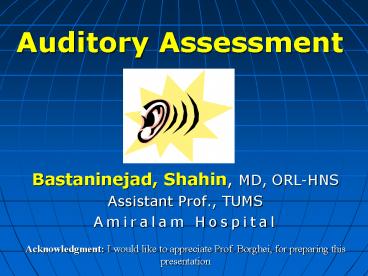Auditory Assessment - PowerPoint PPT Presentation
1 / 34
Title:
Auditory Assessment
Description:
Auditory Assessment Bastaninejad, Shahin, MD, ORL-HNS Assistant Prof., TUMS Amiralam Hospital Acknowledgment: I would like to appreciate Prof. Borghei, for preparing ... – PowerPoint PPT presentation
Number of Views:441
Avg rating:3.0/5.0
Title: Auditory Assessment
1
Auditory Assessment
- Bastaninejad, Shahin, MD, ORL-HNS
- Assistant Prof., TUMS
- Amiralam Hospital
- Acknowledgment I would like to appreciate Prof.
Borghei, for preparing this presentation
2
CHL
SNHL
3
Auditory Assessment
- Subjective tests
- Tuning fork tests (TFT)
- Pure tone audiometry (PTA)
- Speech audiometry
- Objective tests
- Impedance audiometry (Tym,AR)
- Auditory Brainstem Response (ABR)
- Otoacoustic Emission (OAE)
- ...
4
Tuning Fork Tests (TFT)
- Rinnes test
- Webers test
- Absolute Bone Conduction (ABC)
5
Rinnes Test
6
Tuning Fork Tests (TFT)
- Rinnes Test
- Principal ACgtBC
- Rinne ACgtBC, normal hearing or sensorineural
hearing loss - Rinne - ACltBC, conductive HL
- False Rinne unilateral deep SNHL, due to cross
over phenomena ,this can be avoided with masking
7
Webers Test
8
Tuning Fork Tests (TFT)
- Webers Test
- Principal compares the BC of the two ears
- Normal hears equal on both sides or does not
hear at all - Conductive HL lateralized to the more affected
side - SNHL lateralized to the less affected side
9
Tuning Fork Tests (TFT)
- Absolute Bone Conduction test
- (Schwabach test)
- Compares the BC of the examiner with the patient
- Normal equal to the examiner
- CHL longer than the examiner
- SNHL less than the examiner
10
Pure Tone Audiometry (PTA)
- It is the graphic record of hearing
Quantitatively Qualitatively - Pure tones are delivered by head-phone for AC
by a vibrator for BC - X-Axis Frequency range 125 12000 Htz
(routinely depicted from 250-8000 Htz) - Y-Axis Intensity of sound in decibels (dB)
- A decibel is the smallest change in the intensity
of sound which can be recognized by normal human
ear
11
Pure Tone Audiometry (PTA)
12
Pure Tone Audiometry (PTA)
- Normal Audiogram
13
Pure Tone Audiometry (PTA)
- Range of hearing loss
14
Pure Tone Audiometry (PTA)
Conductive Hearing Loss (CHL)
15
Pure Tone Audiometry (PTA)
Sensori-Neural Hearing Loss (SNHL)
16
Pure Tone Audiometry (PTA)
Mixed Hearing loss
17
Masking
- To prevent crossover phenomena
- Crossover happens with
- 40-60 dB AC difference in two ears
- 0-20 dB BC difference in two ears
- Masking problem
- Masking dilemma in bilateral CHL or Bilateral
Mixed HL - Overmasking ? masking noise crosses over to the
other side
18
Speech Audiometry
- Recorded voice is used
- Speech Detection threshold(SDT)
- An intensity level at which a listener can barely
discern the presence of a speech signal in 50 of
the time - It is equal to the PTA average obtained at
500,1000,2000Hz
19
- Speech Reception Threshold (SRT)
- Two syllabus words (Spondee)
- With different intensities
- The intensity at which 50 of the presented words
can be repeated - Measured in dB (it is usually 8-9dB more than
SDT)
20
Speech Audiometry
- Speech Discrimination Score (SDS)
- Mono syllable words
- At 50dB higher than SRT
- Percentage of words recognized correctly is
noted - Normal 96-100
- CHL 90-100
- SNHL low
- Retro cochlear very low
21
Impedance Audiometry
- Objective test
- Includes
- Tympanometry
- Acoustic Reflex
- External Canal Volume (ECV)
22
Tympanometry
- Record of resistance of conductive mechanism of
ear against pressure changes of external canal - Type A normal
- Type B OME, TM perforation, unfit probe, middle
ear mass - Type C Eustachian tube dysfunction
- Type As otosclerosis, tympanosclerosis
- Type Ad ossicular dislocation, or Atrophic TM
- Type D Scarred TM, or normal hypermobile TM
23
Tympanometry
Peak between -100 to 100
24
Tympanometry
Peak usually in-150 to -200
25
Tympanometry
Peak is under -300
26
Tympanometry
27
Acoustic Reflex
- Stapedial muscle contraction in response to loud
noise - 70-100 dB above hearing threshold
- Particularly useful for DDx between Cochlear and
Retrocochlear lesions - Afferent cochlear (8th) nerve
- Efferent facial (7th)nerve
28
(No Transcript)
29
Acoustic Reflex
- Absent bilaterally when tested ear has CHL
- BC must be better than 60dB to elicit this reflex
- AR negative in tested ear but in the
contralateral ? Retrocochlear lesion - AR Positive in Ipsi., but negative in Contra.?
Brain Stem lesion - It also demonstrate level of facial nerve lesion
30
ABR
- Surface recording of the electrical activity of
auditory pathway in response to sound ? Sensitive
for Retro-cochlear lesion - Wave 1 2 cochlear nerve
- Wave 3 cochlear nucleus complex
- Wave 4 Superior olivery complex
- Wave 5 lateral leminiscus
31
Middle and Long Latency Response (MLR,LLR)
Lateral lemniscus
5th
Cochlear nucleus
ABR
3rd
4th
Sup. Olivary Complex
1st and 2nd
32
ABR
33
Oto-Acoustic Emission (OAE)
- Normal cochlea generate a sound Due to the
biological activity of outer hair cells - They are of 2 types
- Spontaneous emission (Spont.OAE?50-70 of people)
- Evoked otoacoustic emission
34
Any Question!?































